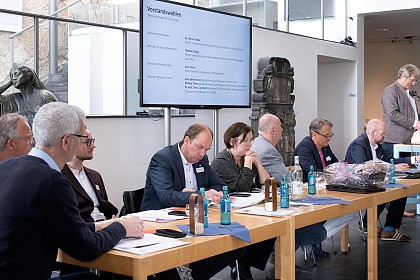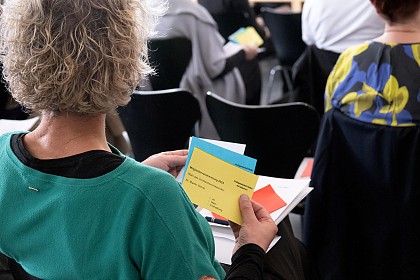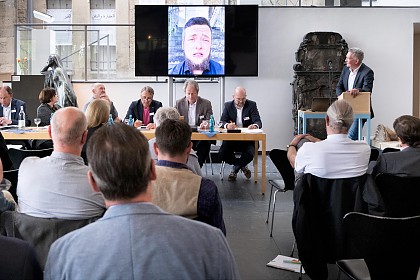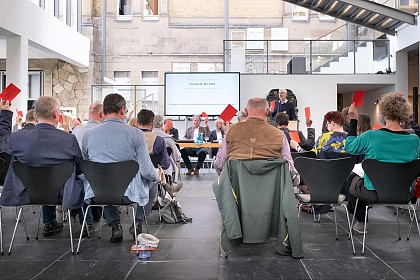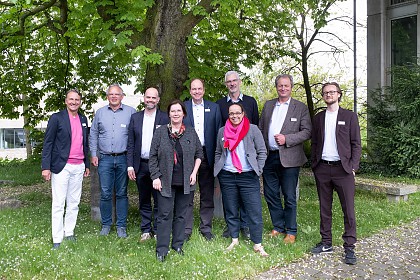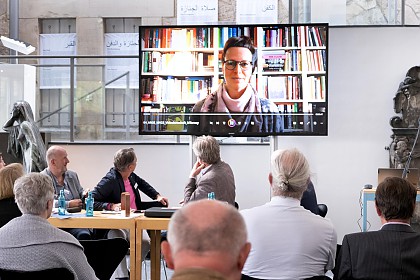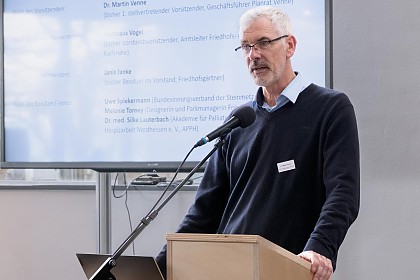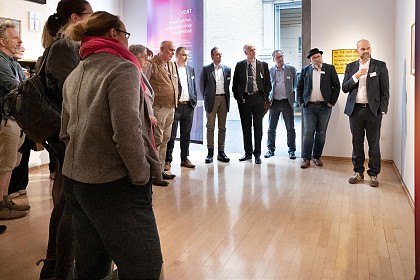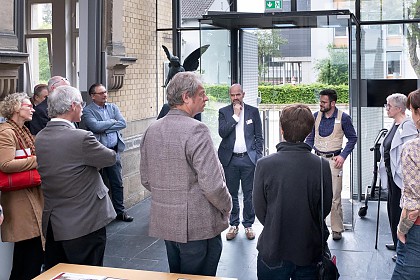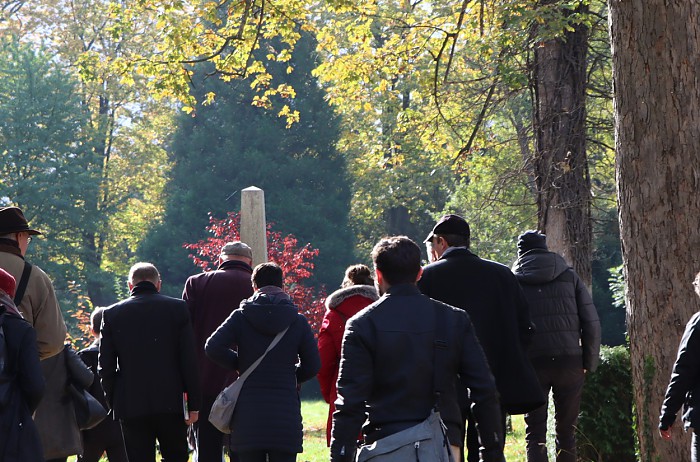

General Meeting and Annual Conference of the Arbeitsgemeinschaft Friedhof und Denkmal e. V. 2024
Venue: Kassel, Museum for Sepulchral Culture
Am 24. und 25. Mai 2024 laden wir wieder herzlich zur Mitgliederversammlung und Jahrestagung der Arbeitsgemeinschaft Friedhof und Denkmal e.V. ein. Im Museum für Sepulkralkultur wird die Versammlung am Freitag mit der gemeinsamen Bearbeitung der jährlichen Regularien starten. Am Samstag freuen wir uns auf regen Austausch im Forum für lebendige Vereinsarbeit.
Programm
Hier finden Sie das Programm zur Mitgliederversammlung 2024 (PDF).
Wir möchten freundlichst darauf hinweisen, dass Anträge auf Erweiterung der Tagesordnung sowie Vollmachten zur Stimmübertragung für die Wahlen bis spätestens zum 10. Mai 2024 in der Geschäftsstelle vorliegen müssen. Ihre Anmeldungen zur Jahrestagung erwarten wir zur Erleichterung unserer Organisation bitte ebenfalls bis spätestens 10. Mai 2024.
Wir hoffen sehr auf Ihre rege Teilnahme, denn wir denken, dass dieses Programm dem Austausch untereinander und der Arbeit unseres Vereins zu Gute kommen wird. Bis dahin wünschen wir Ihnen eine gute Zeit und verbleiben mit den besten Wünschen.
regsitration and questions
Ines Niedermeyer
Position: Secretariat
Telefon: 0561 918 93 40
REGULARIEN
Wahl des Vorstandes
Laut Satzung wird in diesem Jahr regulär die Wahl des Vorstandes (außer des Vorstandsvorsitzenden) stattfinden. Der Wahlvorschlag des Vorstandes orientiert sich an den im letzten Jahr gewählten Vorstandsmitgliedern. Es gibt jedoch eine Änderung. Die im letzten Jahr gewählte Beisitzerin, Melanie Torney, wird ihre Arbeit im Vorstand aus persönlichen Gründen nicht mehr fortsetzen. Für Frau Torney schlägt der Vorstand Maike Sander aus Stuttgart vor, die seit dem Jahr 2005 Mitglied der Arbeitsgemeinschaft ist.
Den gesamten Wahlvorschlag des Vorstandes entnehmen Sie bitte der Tagesordnung.
Satzungsänderungen
Wie Sie der Tagesordnung unter TOP 9 entnehmen können, hat sich der Vorstand dazu entschlossen, die aktuelle Satzung zu ändern. Die Zeitschrift Friedhof und Denkmal wird eingestellt, hier wird aber in diesem Jahr noch eine Abschiedsausgabe erscheinen. Für die Zeitschrift wird die Geschäftsstelle künftig ein Jahrbuch herausgeben. Das Jahrbuch wird einmal im Jahr – möglichst vor der Mitgliederversammlung – erscheinen.
ORGANISATION
Nach den Regularien werden die Autorin Sonja Hartwig und die Fotografin Nora Kurz ihr Projekt „Wer bist du, Tod?“ vorstellen. Danach laden wir Sie zu einer Führung durch die Ausstellung „Dazwischen“ ein, um Sie auf den neuesten Stand der geplanten Neukonzeption des Hauses zu bringen.
Den Abschluss des Tages bildet ein gemeinsames Abendessen im Innenhof des Museums mit Ausklang gegen 23.00 Uhr. Am Samstag, 25. Mai, setzen wir die Jahrestagung mit dem bewährten „Forum lebendige Vereinsarbeit – Mitglieder stellen ihre aktuellen Projekte vor“ fort. Geplantes Ende der Jahrestagung ist voraussichtlich gegen 13.15 Uhr am Samstag.
Report 2023
Suizid-Ausstellung und documenta fifteen waren Höhepunkte in 2022
Mitgliederversammlung der Arbeitsgemeinschaft Friedhof und Denkmal e.V. am 12. Mai 2023
„Der Tod kommt immer unerwartet. Gerade deshalb ist es so wichtig, Rituale zu haben, um damit umzugehen.“ Anlass für diese Worte von Dr. Dirk Pörschmann war zu Beginn der Mitgliederversammlung am 12. Mai der Hinweis auf den Tod von Isabel von Papen, die seit 1997 Bibliothekarin der hauseigenen Bibliothek des Zentralinstituts und Museums für Sepulkralkultur war. Nach einem Nachruf und einem kurzen Innehalten für die geschätzte Kollegin warf Pörschmann einen Blick zurück auf das vergangene Jahr.
weiterlesen
Unter den zahlreichen Sonderausstellungen und den immer wichtiger werdenden Vermittlungsangeboten, die bei der 30. Geburtstagsfeier des Museums besondere Erwähnung fanden, stand das Jahr 2022 im Zeichen der erfolgreichen Suizid-Ausstellung und der Weltkunstaustellung documenta fifteen. Die documenta habe dem Museum in den 100 Tagen der Ausstellung 70.000 Besucher*innen zusätzlich gebracht, betonte Dirk Pörschmann. Die Corona-Krise stieß auch das Museum für Sepulkralkultur in die Digitalisierung und der Innovationsdruck brachte eine Entwicklung auf den Weg, die in die Zukunft reicht. So werden auch weiterhin Sonderausstellungen digital verfügbar gemacht – was dem Museum eine zusätzliche Öffentlichkeit schafft, die Besucher auch in Präsenz ins Museum zieht. Die Suizid-Ausstellung bezeichnete Pörschmann als eine der erfolgreichsten Sonderausstellungen des Hauses bisher. Neu war hier die Verknüpfung mit einem psychologischen Erstberatungsangebot, das sehr gut angenommen wurde.
Auch in Sachen Neukonzeption wurden 2022 wichtige Wegmarken gesetzt, indem Wettbewerbe ein Architekturbüro und ein Büro für Szenografie finden ließen, die nun Umbau und Neukonzeption begleiten. Darüber hinaus bleibt das einzigartige Haus spannend für Projekte unterschiedlicher Art, wofür die zahlreichen Anfragen von Künstler*innen und Initiator*innen sprechen. Auch 2022 wurde die Sammlung um zahlreiche Schenkungen und einige Ankäufe bereichert. Ausgebaut wurden zudem die Angebote im Bereich Soziale Medien. Das Museum ist präsent bei Instagram und Facebook und die Kanäle sind gut frequentiert. Um die Mitglieder aktuell über Arbeitsgemeinschaft und Museum zu informieren, soll es ab sofort einen Newsletter geben, der einmal im Monat verschickt wird. Weiter stehen zahlreiche Tagungen und Seminare auf der Agenda sowie Veranstaltungen wie die Eröffnung des Campus Vivorum in Süßen am 29. Juni und der Runde Tisch Friedhofskultur.
Neuer Vorstand wurde gewählt
Einen Wechsel gab es in der Vorstandsebene der Arbeitsgemeinschaft: Dr. Martin Venne, Inhaber von PLANRAT Venne, wurde am 12. Mai zum neuen Vorstandsvorsitzenden gewählt. Der bisherige Vorsitzende des Vereins, Matthäus Vogel, Leiter des Friedhofs- und Bestattungsamtes Karlsruhe, wurde zu seinem Stellvertreter ernannt. „Wir haben ziemlich große Aufgaben vor uns. Der Ausbau des Museums ist im Gange, wir brauchen einen Generationenwechsel und die Finanzierung der Friedhöfe bleibt ein Thema, das auch unseren Verein mit seiner gesamtgesellschaftlichen Bedeutung betrifft“, fasste Dr. Venne drei ihm wichtige Punkte zusammen. Als Schatzmeister wurde Friedhofsgärtner Janis Janke neu gewählt und die bisherigen Rechnungsprüfer Pfarrer Dirk Stoll und Pressereferentin Swantje Beisheim wurden in ihrem Amt bestätigt. Die neuen Beisitzer sind Dr. Silke Lauterbach, Leiterin der Krankenhausapotheke Helios Kliniken Kassel und Vorstandsvorsitzende der der Akademie für Palliativmedizin, Palliativpflege und Hospizarbeit Nordhessen, die Diplom-Designerin und Leiterin des Projekts „Ohlsdorf bewegt“ auf Deutschlands größtem Friedhof, Melanie Torney sowie Steinmetz und -bildhauer Uwe Spiekermann, Bundesinnungsverband der Steinmetze (Arbeitskreis Friedhof und Grabmal).
Forum lebendige Vereinsarbeit
Vereinsmitglieder stellen ihre aktuellen Projekte vor
Die Arbeitsgemeinschaft Friedhof und Denkmal e. V. hat derzeit 552 Mitglieder aus mehr als 20 Berufsgruppen. Eindrücke in die Arbeit der Mitglieder gab das „Forum lebendige Vereinsarbeit“, in dem Mitglieder aktuelle Projekte vorstellten.
Die Corona-Pandemie sei das Totentanz-Motiv schlechthin gewesen, sagte Museumsdirektor und Geschäftsführer der Arbeitsgemeinschaft Dr. Dirk Pörschmann im Hinblick auf den Vortrag von HENRY SCHUHMACHER, Präsident der Europäischen Totentanz-Vereinigung, einem 148 Mitglieder starken Verein. Letztlich seien es auch die Auswirkungen der Pandemie gewesen, die für ein Umdenken in der Vereinsarbeit gesorgt hatten – und damit für dessen Erhalt. Satzungsänderung, Ausweitung des digitalen Angebots und der Öffentlichkeitsarbeit seien aus der Pandemie heraus entstanden und sorgten angesichts der europaweit verstreuten Mitgliederschaft für bessere Austauschmöglichkeiten. „Wer mit offenem Auge in eine sepulkrale Einrichtung geht, der begegnet dem Thema Totentanz. Anders als bei einem Sportverein ist allerdings mehr Öffentlichkeitsarbeit nötig, um Mitglieder zu halten oder zu gewinnen“, betonte Schuhmacher. Neben dem Ziel, den Begriff Totentanz bekannter zu machen, geht es dem Verein darum, Totentanz-Darstellungen aus der ganzen Welt zu katalogisieren. Hier geht es zur Homepage: https://www.totentanz-online.de/totentanz.php
Steinbildhauermeister UWE SPIEKERMANN stellte vier Projekte zum Thema Sternenkinder vor und wies zunächst einmal darauf hin, dass nicht grundlegend geklärt sei, was ein Sternenkind sei. Wie auch später seine Kollegin Lioba Abrell, nannte er etwa das Beispiel, dass aktuelle Sternenkind-Gedenkstätten oder -Grabanlagen etwa auch von Eltern besucht würden, deren Kinder vor vielen Jahren starben. Das Thema Sternenkinder sei von großer Bedeutung und trotz weitreichender Angebote für die Hinterbliebenen nach wie vor in der Öffentlichkeit unterrepräsentiert, weil tabuisiert. Beispielhaft berichtete Spiekermann von vier Projekten in und im Umkreis von Hannover: Orte des Gedenkens und Begräbnisstätten für Sammelbeisetzungen, die allesamt das Merkmal haben, individuell, also nach den Bedürfnissen der Trauernden gestaltet werden zu können. Formen dafür ist die Gestaltung von Steinen gemeinsam mit Hinterbliebenen sowie die Option, dass diese die Flächen individuell dekorieren. Finanziert würden diese Orte zumeist von Stiftungen oder über private Spenden. Der Vorteil der Sternenkind-Anlagen sei, dass diese auch auf kleinen Friedhofsflächen umsetzbar seien, die für reguläre Grabstätten nicht geeignet sind.
Bildhauer MICHAEL SPENGLER (Atelier denkwerk Berlin) hat einen Volvo Baujahr 1988, der 33 Jahre lang in Neapel als Bestattungsfahrzeug fungierte, in die mobile „Galerie im Schneewittchensarg“ verwandelt. Vier Ausstellungen zu den Themen Leben, Liebe und Tod hat der Berliner darin bereits gezeigt, in denen er Poesie und bildhauerische Arbeit verknüpft. Inspiration für seine aktuelle Ausstellung war eine Zeichnung, die seine Tochter mit sieben Jahren angefertigt hatte. Diese setzte er in ein Relief um und ergänzte es um einen poetischen Impuls in einem Leuchtkasten. „Das ist meine künstlerisch unterhaltsame Art der Auseinandersetzung mit Trauer und Tod.“ In seinem Berufsalltag entwickelt Spengler Grabzeichen, die in Form und Material unverwechselbar mit dem Verstorbenen in Verbindung stehen sollen.
Wie erhält man einen historisch und kulturell wertvollen Friedhof und öffnet ihn dennoch zur Nutzung für die Allgemeinheit? Mit dieser Frage beschäftigt sich die Friedhofsverwalterin LARA SCHINK (Neuer Annenfriedhof, Dresden). In ihrem Vortrag ging sie auf den aktuellen Stand des öffentlich geförderten Projekts „Green Urban Labs II – Vom Parkfriedhof zum Friedhofspark“ ein, in dessen Mittelpunkt ein Teil des Neuen Annenfriedhofes steht. Der Neue Annenfriedhof sei die bei Weitem größte Grünfläche im Stadtteil und werde von Bürger*innen vielseitig genutzt. Um die Fäden der Nutzung in der Hand zu behalten, hat die Friedhofsverwaltung einen Gemeinschaftsgarten für Bürger*innen geschaffen. Es sei geplant, im alten Mitarbeiterschuppen ein Trauercafé zu installieren und die Entwicklung des Parkfriedhofs passiere mit intensiver Bürgerbeteiligung. Parallel dazu laufen Forschungen etwa in den Bereichen Artenschutz, Erinnerungskultur und Kunst, und es werden digitale Angebote erarbeitet. Ziel des gesamten Projekts sei es „grundsätzliche Weisheiten zu erlangen“, um künftig weitere Friedhofs-Projekte dieser Art betreuen zu können. Eine Herausforderung sei es, die Finanzierung langfristig zu gewährleisten. Da die Annenfriedhöfe nicht in kirchlicher Trägerschaft sind, strebe man an, die Stadt Dresden über einen Pachtvertrag ins Boot zu holen, um so ein langfristiges Bestehen des Projekts gewährleisten zu können.
LIOBA ABRELL ist Steinbildhauerin, Künstlerin und Trauerrednerin. Die Themen Sterben, Gebären, Tod und Leben beschäftigen sie seit Langem, sodass sie sich über unterschiedliche Disziplinen den Themen widmet. In der 2500-Einwohner-Gemeinde Aitrach in Baden-Württemberg hat sie auf einem traditionellen Friedhof neue Beisetzungsangebote geschaffen. Statt einem Platz für anonyme Beisetzungen und Kolumbarien entwickelte sie ein Urnengemeinschaftsgrabfeld mit Stelen, die beschriftet werden können, sowie einer einfach gehaltenen Dauerbepflanzung, die bei Bedarf nachgepflanzt werden kann – ein Projekt, das wegen des großen Anklangs bereits erweitert wurde. Ein weiteres Projekt auf dem Friedhof war die Schaffung eines Grabfelds für Sternenkinder auf Initiative von Müttern, die dem Thema damit mehr Öffentlichkeit schenken wollten. Abrell habe dabei herausgefunden, dass der Verlust eines Kindes manche Mütter bis zum eigenen Tod beschäftige, vor allem dann, wenn in der Vergangenheit durch Stigma und Scham bedingt, keine Trauerarbeit geleistet werden konnte. Entsprechend gestalte sich auch die Nutzung des Sternenkindergrabfelds mit nahegelegener Sitzbank, das über den Beisetzungsort hinaus auch als Erinnerungsort fungiere. Als Trauerrednerin erhalte sie wertvolle Einblick in Familien und erlebe immer wieder, wie Hinterbliebene im Gespräch selbst Neues über den Verstorbenen erfahren. Um Sterben, Tod und Trauer dreht sich zudem ihre künstlerische Arbeit – etwa anhand ausgehöhlter Flusssteine, die das „Licht im Inneren“ freigeben.
Der Friedhof der Zukunft, das hätten bereits einige Beiträge deutlich gemacht, sei ein gemeinsam gestalteter, merkte Dr. Dirk Pörschmann an. „Wir kommen immer weiter weg von ‚So wird gestaltet‘ hin zu ‚Das ist unser Friedhof, und wir gestalten ihn gemeinsam.“
Ein weiteres Beispiel des individuellen Trauerns ist die Trauerhaltestelle auf dem Ohlsdorfer Friedhof, die 2021 geschaffen wurde. DR. SIMON WALTER und MEL SETTELE (Stiftung Deutsche Bestattungskultur) berichteten von einer lebendigen und wertschätzenden Nutzung des Trauer- und Gedenkortes, der zudem interkulturell funktioniere – was Walter auch darauf zurückführt, dass er auf jegliche Vorgaben zu Symbolik und Konnotation verzichtet. Ein nach mehreren Seiten offenes Gebäude, das aus hellen Wänden besteht, können Trauernde nutzen, um mit Kreide Texte und Bilder zu hinterlassen. Auf an der Wand befestigten Brettern können zudem Erinnerungsgegenstände platziert werden. Insbesondere an den Außenwänden wasche der Regen die Kreide ab, was wiederum ein schönes Symbol von Vergänglichkeit sei, hieß es im Gespräch im Anschluss an den Vortrag. Die restlichen verwischten Spuren der Kreidefarbe wiederum können als Metapher gesehen werden, dass jeder Mensch Spuren hinterlasse. Der Erfolg der Trauerhaltestelle habe laut Walter viele weitere Interessenten an einer solchen Trauerhaltestelle hervorgebracht. Aktuell entsteht ein Film, um die Hintergründe des Projekts zu erläutern und in einer Kooperation mit der Uni Hamburg sollen Trauer- und Gedenkorte im öffentlichen Raum erforscht werden.
Mit den Worten, es mache uns zu Menschen, unserer Toten zu gedenken und zwar kulturübergreifend, leitete Dr. Pörschmann über zum letzten Vortrag der Tagung.
Steinmetz und Steinbildhauer DOMINIK PATTÉ berichtete von dem Prozess um die von der Partei Bündnis 90/Die Grünen in Sachsen-Anhalt angestoßenen Novellierung des Bestattungsgesetzes. Auf Anregung der Landesinnung des Steinmetz- und Bildhauerhandwerks sei eine Arbeitsgruppe gebildet worden, um eine Überarbeitung gemeinsam zu diskutieren – mit Friedhofsverwaltern und -gärtnern, Bestattern, Steinmetzen, der Evangelischen Kirche und dem Städte- und Gemeindebund. Es seien Kompromisse gefunden worden, die die Wünsche der Grünen aufgriffen und sowohl den Gewerken als auch den menschlichen Bedürfnissen zur Friedhofs- und Bestattungskultur gerecht werden sollten. Eine Stellungnahme mit denkbaren und handhabbaren Formulierungen wurde an den Landtagspräsidenten übergeben, damit diese möglichst in den Gesetzentwurf der Landesregierung einfließen. Mit der Initiative, einen Arbeitskreis zu bilden, hat die Innung dazu beigetragen, die Bedeutung der einzelnen Gewerke zu stärken und gemeinsam Veränderung auf den Weg zu bringen.
Auch bei Themen und Prozessen wie dem von Patté geschilderten, könne auf das Knowhow der Mitglieder der Arbeitsgemeinschaft zurückgegriffen werden, merkte Dr. Dirk Pörschmann abschließend an. So individuell die Sichtweisen der einzelnen Gewerke ist auch die Friedhofs- und Bestattungskultur an sich – dieser Schluss resultierte aus dem „Forum lebendige Vereinsarbeit“.
Reports from past annual conferences
Every year, an annual conference with a professional focus and the general meeting of the Study Group Cemetery and Monument take place in Kassel.
(The offer is directed exclusively to members of the Study Group)
Here you will find reports of the past meetings.
Annual and General Meeting 2022
Place: Museum for Sepulchral Culture Kassel
CONFERENCE REPORT
Regularities of the General Assembly
Main topics
"SUIZID – Let's talk about it!" This was the title of a special exhibition at the Museum for Sepulchral Culture which attracted more than 11.000 visitors from 11. September 2021 to 3. April 2022. The exhibition and the accompanying programme served to remove the taboo and destigmatise suicide as well as the experiences and circumstances that trigger it," explained Director and Executive Director Dr. Dirk Pörschmann in his review of the year at the beginning of the general meeting and annual conference of the Study Group Cemetery and Monument (Arbeitsgemeinschaft Friedhof und Denkmal e. V.). The accompanying publication, published by Kerber-Verlag, contains about 50 articles and almost 400 pages. It is available in the museum's online shop at a special price of 29 €.
Dr. Pörschmann also informed the audience about the planned major museum reconstruction and new conception, for which a competition is already underway. A move to temporarily different premises is planned for 2023 in order to be able to reopen the newly designed museum in autumn 2026.
New election of the Appeals Committee and the auditors
The members of the Appeals Committee were confirmed in office: Adalbert Schmidt from the Evangelical Church Germany, Christof Keldenich from Aeternitas e. V. and Prof. Dr. Torsten Barthel, legal advisor to the Association. The auditor Jürgen Rehs, who was not available for re-election, was thanked for his many years of reliable service. He is now replaced by Swantje Beisheim from Kassel. Rev. Dirk Stoll was confirmed in his office as auditor.
Amendment of the Statutes
The General Assembly decided that the name "Arbeitsgemeinschaft Friedhof und Denkmal" (Study Group Cemetery and Monument) will be written out in full until agreement is reached on a new abbreviation and that the abbreviation "ARGE" will thus be dispensed with. This change as well as some minor formal adjustments in the statutes were unanimously approved by the General Assembly.
Contribution increase in 2023
The necessary increase of the membership fee was discussed. The Executive Board had postponed it, which is why it was not possible to implement the immediate adoption of increased membership fees as requested by the members. During the 2023 General Assembly, the membership fee for individuals should be increased from 90 to 100 euros per year and the membership fee for corporate members from 130 to 150 euros per year. In this context, the development of the number of members came up, which had decreased again from 2020 (587) to 2021 (576).
Accompanying programme
What is "Recompose"?
After the regularities, Pablo Metz, who was connected via video call, introduced the "Reerdigung" ("Recompose") and thus a new form of burial in the ground. "Cremation emits CO2 and harms our environment and our future," said the initiator of "reburial" in Germany and co-founder and managing director of "Meine Erde" – a service offered by Circulum Vitae GmbH based in Berlin. Turning the body back into earth is a natural process, he said. During the "Reerdigung", the deceased is placed in an "alvarium" set up at the cemetery in a "cocoon" made of stainless steel, which is sealed. There, the body, bedded on a cushion of straw and flowers, transforms into earth in 40 days in the wood-panelled "honeycomb" with the addition of oxygen. During this time, the "cocoon" is turned once. According to Metz, 15 per cent of the bones remain; with cremation it is 35 per cent. After that, the earth is buried in the cemetery of choice. A "Reerdigung" costs as much as a traditional urn burial (1.800 €), he said. The investment costs for the alvariums and cocoons are covered by the company. Two "reburials" have already taken place in Schleswig-Holstein and the initiators are trying to gain further acceptance. In the discussion, the energy consumption in comparison to conventional body burial and cremation was questioned.
Forum on living association work
The "Forum on Living Association Work" subsequently proved to be a good format. Nine members took the opportunity to present their current projects for discussion. The topics of the association members can be read in the PDF (download). The format will continue during the annual conference on 12 and 13 May 2023. The venue will again be the Museum for Sepulchral Culture in Kassel.
Annual & General Meeting 2021 / 100th Anniversary ot the ARGE
October 15th to17th, 2021 in Dresden
Corona & Charter characterize annual meeting
The Study Group Cemetery and Monument (Arbeitsgemeinschaft Friedhof und Denkmal e.V.) held its annual meeting in Dresden for a special occasion. While the members elected a new board, executive director Dr. Dirk Pörschmann described the change towards a virtual culture business.
For this year's annual meeting, the Study Group (ARGE) had chosen a special venue for this year's annual meeting. Thus the ARGE invited its members from 15th to 17th October not as usual to Kassel, but to Dresden. The background for the change of location was that the Reichsausschuss für Friedhof und Denkmal (Reich Committee for Cemetery and Monument) had been founded in the Saxon state capital exactly 100 years ago in the course of the cemetery and monument reform.
The three-day event kicked off with the general meeting in the time-honored Lukaskirche. Martin Venne, deputy chairman of the ARGE, first commemorated the deceased members, including Wolfgang Thust. On October 12, the highly esteemed master stonemason from Balduinstein had passed away. Thust was in 2019 as only third person the honor to be honorary member of the ARGE. Accordingly, Venne paid tribute to the services of the entrepreneur: "Wolfgang Thust worked tirelessly for the preservation of cemetery culture until the end of his life. The board appreciated and continues to appreciate Wolfgang Thust's commitment beyond measure."
ARGE Managing Director Dr. Dirk Pörschmann reviewed the activities in the past fiscal year 2020. As expected, cultural work was extremely challenging for ARGE due to the Corona crisis. For example, Pörschmann spoke of the fact that as a result of the first lockdown in March 2020, the Kassel Museum for Sepulchral Culture lacked the basis for its activities. After the institution was still able to enjoy around 25,000 visitors in 2019, the number collapsed to around 8,000 due to Corona.
Now also virtual events
However, instead of resigning themselves to the difficult situation, they quickly recognized the many possibilities offered by digital communication channels. In the meantime, virtual events are just as much a part of the daily routine as museum tours conducted via online stream, Pörschmann explained: "The virtual museum has now firmly established itself alongside the real one."
In some ways, ARGE's offerings, because of their engagement with death, have even benefited from the Corona crisis, he said. "The topic of dying has been very present in the media since the start of the pandemic, as a result of which some of our exhibitions have received exceptionally high press coverage," the managing director summed up. This was especially true for the special exhibition "Zernetzung" by artist Macro Di Carlo in the summer of 2020, but also applies to the current exhibition "Suizid – Let's talk about it!" which runs until February.
Meanwhile, as 2021 is already drawing to a close, Pörschmann further marshaled the current state of the cultural industry. Although Corona continues to be the dominant topic, he now sees light at the end of the tunnel. For example, he said, things are currently looking up noticeably, which means that a positive development is clearly discernible despite the difficult start to the year. "To get back to pre-Corona levels, however, we probably need another two to three years." ARGE Chairman Matthäus Vogel expressly congratulated Pörschmann and his team for the solid economic figures they were able to achieve despite the more difficult general conditions.
Into the future with a proven team
In accordance with the ARGE association statutes, all board members with the exception of the chairman were newly elected this time. In contrast to the other board members, the chairman is elected every four years instead of three. In terms of personnel, there were no changes in the course of the election. First Martin Venne as 1. deputy chairman, Edith Strassacker as 2. deputy chairman and Wolfgang Gieße as treasurer stood for re-election. All three were confirmed according to bird with overwhelming majority in their offices. The picture was similarly clear for the board's assessors. Prof. Dr. Norbert Fischer, Stephan Hadraschek, Hermann Freymadl, Janis Janke, Holger Geister and Dr. Simon Walter also received the confidence of the members present with a large majority.
Charter for cemetery culture
Finally, the vote on the Cemetery Culture Charter provided ample material for discussion. The charter was formulated in cooperation with the Kuratorium Immaterielles Erbe Friedhofskultur and other industry associations. In Dresden, the ARGE members were now called upon to make comments and additions to the previous draft. In principle, the charter is intended to send out a clear, strong and, above all, positive signal for cemetery culture. Based on this basic attitude, it should make clear why cemetery culture is so important for our society. Ultimately, it is intended as an instrument to bundle the many-voiced chorus of those who dedicate themselves to the broad field of cemetery culture and to place it on a common basis, as Pörschmann summarized.
In addition to fine-tuning individual formulations, one of the issues discussed was the extent to which the initiators enter into certain obligations by signing the charter. Here the unanimous tenor was "no", at least with regard to real conditions. If at all, moral obligations were primarily associated with the charter. Rather, it is intended to give cemetery culture a framework for social discussion and to help it gain more visibility in the public eye. The question of its scope was also clarified. According to this, the charter refers solely to Germany in accordance with UNESCO, which has also granted the status of intangible cultural heritage to German cemetery culture alone. The collected comments now serve to further concretize the draft charter. The official signing is scheduled for November 18 of this year. This discussion marked the end of the general meeting, which this year was not only held in a new location, but also later than ever before. In 2022, the ARGE will return to its usual rhythm with a date in the first half of the calendar year. The planned date is May 20, 2022, at Kassel's Museumfor Sepulchral Culture.
Filip Lachmann
Filip Lachmann is a trained journalist. After working in corporate communications and PR, he freelances as an editor and photographer for various trade magazines.
Symposium and guided tours of selected cemeteries
On October 15, 1921, the "Reich Committee for Cemetery and Monument" – was founded in Dresden. Thirty years later followed the Study Group "Arbeitsgemeinschaft Friedhof und Denkmal e. V." The association took this date and this place as an opportunity to hold this year's general meeting in Dresden and to organize a symposium with contributions mainly on the history of cemetery reform in the European context, as a basis for a critical discussion.
Guided tours of the Tolkewitz Urn Grove and the New Annen Cemetery
After the end of the annual conference, there were informative and entertaining guided tours of the Tolkewitz Urn Grove with Professor Jan-Michael Lange and Martin Kaden, Natural History Collections Dresden, as well as Jens Börner, Head of the Department of Municipal Cemeteries and Burial Services Dresden. In the evening the Literaturtheater Dresden with Annette Richter, Herbert Fischer and Christian Mögel invited to an imaginative walk through the cemetery with a special view on Russian burial customs.
Lara Schink, cemetery administrator of the Annenfriedhöfe Dresden, led a tour of the approximately 14-hectare Evangelical Lutheran New Annen Cemetery in the Löbtau district. At least one cemetery with additional design regulations formed a bridge to the symposium topic of the previous day. In this section, compliance with the regulations is to be given greater consideration again in the future for design reasons. However, communal graves were presented as the currently most popular grave design. The entrance area of the cemetery, designed as a park in 1875 by Robert Wimmer, a student of Gottfried Semper, is formed by a monumental camposanto architecture. There are still a lot of historical grave grids in the cemetery, for which, in addition to the problem of their preservation, the problem of frequent material disuse was discussed. Lara Schink pointed out that existing memorial sites are extended by users to become memorial sites for other memorial occasions, which is a practical example of cemetery users redesigning the cemetery according to their needs. Furthermore, the participants were introduced to a cemetery border that had been purposefully opened for extensification and it was explained that its overgrown appearance is interpreted by the administration as an enchanted area. The western cemetery area, called "Peace and Hope", is part of the federal project Green Urban Lab II, according to Lara Schink's report. In the course of which, she said, the question of where the boundaries of a conversion to a park lie should be explored. On the one hand, such a conversion to a park would contribute to an enhancement of the district, on the other hand, the compatibility with regard to the core functions of the cemetery had to be examined. Already since 2018, a cemetery development plan for the entire cemetery had envisaged a conversion to a park. In this context, there are also plans to possibly convert a building at the edge of the cemetery into a café. In addition, the participants could see that a fenced-off part of the cemetery is given to the "Gartennetzwerk Dresden" for use as a kitchen garden. In many places of the tour, summarized Dirk Pörschmann with thanks to Lara Schink, the participants had shown networks between the cemetery and the city of Dresden, which are basically positive.
Dr. Dagmar Kuhle
Annual & General Meeting 2019
May 24 and 25, 2019 in Kassel
The grave and its central functions for the people are at the centre of the work of the Study Group Cemetery and Monument, emphasised Managing Director Dr. Dirk Pörschmann at the annual conference on 24 May. Thus the Study Group is also the idealistic sponsor of the project "Healing Farewells".
As new managing director, Dr. Dirk Pörschmann put the work of the association to the test one and a half years ago. In two closed meetings the board of directors worked out new priorities for the next years. The grave and its central functions for the people should be in the centre. In addition, the Study Group wants to focus on the other qualities of a cemetery, especially its secondary functions in the areas of recreation, communication and ecology. In addition, the association is working on updating the permanent exhibition at the Kassel Museum for Sepulchral Culture, which most recently presented pictures and sculptures by the sculptor Stephan Balkenhol. In 2018, 22,000 visitors took advantage of the rich offerings of this unique cultural institution, which is funded by the city, state, federal government and the churches. The journey there is always worthwhile. Director Dr. Dirk Pörschmann informed about last year's exhibitions and the manifold activities of the museum in his activity report.
Honorary member Wolfgang Thust
At the annual conference and general meeting, board elections were scheduled. Matthäus Vogel was confirmed in his office as chairman for the next four years. The deputy positions were newly filled: First deputy is now cemetery planner Dr. Martin Venne. The members elected Dr. Jutta von Zitzewitz, Cultural Officer of the Board of Trustees for German Funeral Culture, as the second deputy chairman. Background: Gustav Treulieb, Federal Guild Master in the Federal Association of German Stonemasons, had resigned from his office in order to make a new appointment possible. The Study Group appointed Wolfgang Thust, who can look back on 200 years of company history, as the third honorary member (after Wolf Spemann and Jörg Bollin). "We have to fight", he said, "but we can make something out of the difficult situation at the cemetery – we just must not give up!" A tribute for the 50 years of membership of the Kunstgießerei Strassacker was received by its managing director Edith Strassacker, among others.
Forum "Living association work"
A new concept is the "Forum for living association work", where association members present their current projects. Together with Gerold Eppler, Michael Spengler explained the cinema film "Der Stein zum Leben" (the stone for life), which is shown nationwide. Philipp Baisch introduced the Association for Biodiversity in cemeteries.
Healing Farewells
Günter Czasny, deputy managing director of the Strassacker art foundry, presented the project "Healing Farewells" under the idealistic sponsorship of the Study Group. Long-term research into problems and the benefits of the cemetery and especially the individual actions possible there at the grave for mourning people will be presented on 25 October at a congress with futurologist Matthias Horx at Maternushaus in Cologne, with broad support from all institutions involved in the cemetery as well as experts from sociology and psychology.
On May 25th, some members took part in a visit to the Mulang cemetery in Kassel and a guided tour of the Unesco World Heritage Site "Bergpark Wilhelmshöhe" with a focus on "architectural mock graves".
Bärbel Holländer
Bärbel Holländer is editor-in-chief
of the journal Naturstein
Annual & General Meeting 2018
June 8 and 9, 2019 in Kassel
Exchange with ALL
New elections, workshops on megatrends and the inauguration of Dr. Dirk Pörschmann as General Manager of the Study Group Cemetery and Monument (Arbeitsgemeinschaft Friedhof und Denkmal e. V.) and Director of the Central Institute and Museum for Sepulchral Culture were the focus of the annual conference of the Study Group Cemetery and Monument on 8-9 June in Kassel.
The Study Group Cemetery and Monument (Arbeitsgemeinschaft Friedhof und Denkmal e. V.) has a new managing director and the museum and the Central Institute have a new director. The chairman Matthäus Vogel was pleased about this in his welcoming address and opening of the annual conference of the Study Group in the Museum for Sepulchral Culture. 2017 had been marked by the search for a new management and the participation in the "documenta". The latter had brought the museum 70,000 additional visitors (a total of 93,000) and corresponding additional income. Vogel thanked all of the museum's staff and in particular the provisional managing director and museum director Gerold Eppler for their successful commitment.
We want to be heard
"The first five months in office have shown me that I have taken on new activities that broaden my horizons, challenge my stamina, keep my creativity alive and put my diplomatic skills to the test," Dr. Dirk Pörschmann admitted in his inaugural speech. After the two years of vacancy for the position of Managing Director, he said, many things were put to the test. "The topics of sepulchral culture are so diverse, topical and relevant that it must be a great concern for us to take part in the public discussions in the context of cemetery and monument", said Pörschmann. "We want to be heard, and for this we need the cooperation of all trades and communication with all members," he announced as the result of a closed meeting with the board and the employees of the working group. The great challenges, which lie in the breadth and diversity of the institutions association, museum and central institute, would at the same time contain a great opportunity: "Namely, to discuss in exchange with ALL those who, professionally or privately, economically or ideologically, are concerned with the end of life and its integration into life, and to arrive at a synthesis in the old tradition of thesis and antithesis, which can only arise together. Together we can achieve a better level of knowledge and clearer positions, which will lead to us being heard in public".
Fit for the next 20 years
Dr. Dirk Pörschmann named the renovation of the building, the expansion of the museum's facilities and the restructuring of the presentation of the collection as further major challenges. The house is 26 years old, the permanent exhibition in its current form has already lasted too long, and in many areas the potential of the museum and the topics dealt with is not being fully exploited. "Together with our team, I would like to change this, so that we can make the house fit for the next two decades," he announced. He said it was a central concern of his to "welcome all social classes, all generations, all religions and also all ethnic groups into our house". He saw his task more in shaping than in managing. He will continue to optimize the necessary administrative processes and carry them out conscientiously and quickly, "but I would like to bring my creativity and enthusiasm to bear elsewhere. Namely, where people are concerned and the issues that make it so existential for them to deal with life and death.
Newly elected ... were the deputy chairmen, the treasurer and the assessors. The deputy chairmen Gustav Treulieb and Dr. Martin Venne were confirmed in their offices as well as treasurer Wolfgang Gieße and the assessors Prof. Dr. Norbert Fischer, Edith Strassacker from the Kunstgießerei Ernst Strassacker, Stephan Hadraschek from Otto Berg Funerals, stonemason and stone sculptor Hermann Freymadl and cemetery gardener Holger Geister. New as an observer is the cemetery gardener Janina Janke. Numerous individuals, companies and institutions were honoured for their longstanding membership in the Cemetery and Monument Working Group.
Workshops on megatrends relevant for the cemetery
After the general meeting, four workshops (moderation: Birgit Aurelia Janetzky) dealt with social influences with concrete effects on the development of cemeteries. As megatrends relevant for the association, the board had chosen "population development", "urbanisation", "ecologisation" as well as "digitalisation and internet culture". There were lively discussions in all four workshops, which were led by employees.
The participants agreed that the above-mentioned megatrends are already having a significant impact on the cemetery and that these changes are irreversible. They all agree that the association should accompany the change as a provider of ideas and a pioneer, inform its own network and "round tables" with trades and take away fears by offering advice.
Bärbel Holländer, Editor-in-Chief NATURSTEIN
The Journal for Sepulchral Culture reports in detail about the meeting in its 2/2018 issue.
Honours
The following persons/ companies/ institutions were honoured at the conference for their 25 or 50 years of membership in the Study Group:
Gold
Wolfgang Becher, stonemason Helmarshausen, Bad Karlshafen
Friedhelm Krumme, Lüdinghausen
Daniel Wöhler, Bremen
Cemeteries Vienna GmbH, Vienna
Silver
Anton Hebensteiner, Munich
Wolf-Dieter Grimm, Munich
Fred Grimm, Volkach
Karl-Heinz Berg, Höxter
Paul Hofmeister, Hofmeister Bestattungen GmbH, Fellbach
Christoph Drescher, run
Wiegand Funerals GmbH, Ilmenau
Burials Dabringhaus in the Thanatorium, Stockelsdorf
Treulieb GmbH, Stuttgart
Cemetery administration of the city of Halberstadt
Friedrich Carl Heimann Society, Cologne
Stichting Nederlands Uitvaartmuseum, Amsterdam
Lentia Marble Natural Stone GmbH, Linz
Annual & General Meeting 2017
June 23 and 24, 2017 in Kassel
In 2017 the city of Kassel presented itself with documenta 14, and if we emphasize this aspect, it is because the Museum for Sepulchral Culture itself became a documenta location. The level of awareness of our museum has thus increased enormously.
However, the annual conference in Kassel was primarily used to discuss a repositioning of the Study Group Cemetery and Monument (Arbeitsgemeinschaft Friedhof und Denkmal e. V.) with its members. After questions about values and objectives were again asked at the last general meeting, the key points of a possible repositioning were presented. In workshops the first aspects of the content were critically discussed. Four topics were available for selection. A first summary of the results as well as the opportunity for further discussion were made available in the forum of the Study Group.
The general meeting agreed to continue the work in the workshops at the annual meeting 2018.
Annual & General Meeting 2016
June 16 and 17, 2016 at Fürstenried Castle (retreat house), Munich
On June 16th 2016, the members of the Study Group Cemetery and Monument (Arbeitsgemeinschaft Friedhof und Denkmal e. V.) met in Fürstenried Castle, the retreat house of the Archdiocese of Munich and Freising. In the princely ambience the meeting of the association took a quiet course despite the drastic changes in the office. Matthäus Vogel, as chairman of the Study Group, informed those present about the surprising departure of PD Dr. Werner Tschacher. After his festive inauguration with well-known representatives of the federal government, the state of Hesse, the two churches of Germany and the city of Kassel, Tschacher has already left the varied field of duties of the director of the Museum for Sepulchral Culture and the managing director of the working group. The board of the working group has therefore appointed the author of this article as provisional director of the museum until 2017, when a new decision will be made on the appointment.
Thanks to the clear presentation by treasurer Wolfgang Gieße, the presentation of the annual financial statement 2015 and the preliminary economic plan 2016 did not give rise to any critical questions, and the report of the auditors, presented by Jürgen Rehs, did not give rise to any objections. The members gratefully accepted the offer of Jürgen Rehs and Pastor Dirk Stoll to continue to make themselves available for the office of auditor.
The motions submitted for voting were all accepted by a majority. The general meeting was unanimously prepared to comply with the request of the tax authorities to amend the statutes of the working group in such a way that, for example, the purpose of the association corresponds to the exact wording of the model statutes of the German Fiscal Code. Since the changes affect all associations and affect neither the tasks nor the objectives of the Study Group, the corresponding wording will now be incorporated into the statutes.
Concerning the increase of the membership fees, concerns were expressed. Nevertheless, a large majority considered it necessary to make an adjustment after more than fourteen years of constant amounts. Those interested in membership who, for example, have not yet gained a professional foothold after completing their training or studies, can apply for a reduction on request.
The creeping loss of members also preoccupied those present. Numerous suggestions were made to stop this. A platform that could be used across associations to discuss even conflicting views on developments in the field of sepulchral culture was one of them, as was the suggestion to offer workshops again at members' meetings. It was agreed that these could provide impulses for active participation in the work of the association. Because this also became clear: the need for advice, especially in the cemetery area, is increasing and cannot be met by the staff of the office alone. Contact persons should therefore be sought among the members in order to establish structures for regional association and advisory work. Since such a request can hardly be implemented without appropriate advertising material, the board was also asked to expand press and public relations work and to offer members not only leaflets but also roll-ups, displays and banners for trade fairs and other events.
The first day of the general meeting will end with a presentation on the new Munich Riem cemetery. Dipl.-Ing. Ursula Hochrein, as the responsible landscape planner, personally presented the concept of this cemetery, which is unique in Europe. On the one hand, this conveyed to the audience the complexity of the design task. On the other hand, many subtle design settings were revealed, in which the landscape architects took up the needs of those affected and visitors in order to create an environment that corresponds to the emotional situation of the mourners. Surprising for all experts was the observation that in view of the problems many cemetery owners have with so-called overhanging areas, a 13-hectare cemetery complex was created in Riem between 1998 and 2000. Despite the strong population influx, this cemetery will still have sufficient capacity in decades to come.
This generosity is impressive. Four cemeteries lie – quasi like islands – in a landscape of meagre meadows. They are bordered by gneiss walls in dry construction and are raised by one meter due to the high ground water level. Earth walls block the view of the burial area from the footpaths and cycle paths that cut through the cemetery. Every single cemetery area gets a manageable size due to this lean grass fence. However, because the consistent reduction of design elements and materials is repeated in all departments, even if they are not yet occupied, the entire complex appears as if it has been cast from a single mould and – despite its closed and clearly defined basic structure – remains open for new, future gravesite concepts.
If architectural clarity and almost monastic austerity are characteristic of the Munich Riem Cemetery, then forest and nature are the defining features of the Munich Forest Cemetery. A visit to this complex, designed by Hans Grässel and inaugurated in 1907, was obligatory for the Study Group on the second day of the general meeting. For it was here that the cemetery reform movement began. To this day, a part of the self-conception that constitutes the identity of the association can still be experienced here.
At exactly 10:30 am the city cemetery guide Klaus Harder welcomed the group at the old entrance gate. Starting from Hans Grässel's grave of honour, Klaus Harder led the excursion participants to the oldest grave of the Waldfriedhof to explain Grässel's design idea together with Dagmar Kuhle and the author. The criteria of craftsmanship, homeland reference and religiousness had to be reflected in the design of the gravestones. At the same time, the atmospheric atmosphere of the forest was to be preserved by prescribing stone materials that quickly set moss and lichen. The reference to these restrictions regarding the materials to be used in the Waldfriedhof provided the keyword for the natural stone expert, Prof. Dr. Wolf-Dieter Grimm, who examined and catalogued the monument stones of all Munich cemeteries. He spontaneously explained once again the special nature of the Waldfriedhof, which is evident in the selection of certain types of rock and gives the complex a special character.
Now the Waldfriedhof is already due to its size anything but manageable. For almost three hours the guides led the group on winding paths through the forest. They passed chapels, family graves, monuments and tomb monuments for writers, artists, circus directors and brewers. Again and again, sculptures were discovered that one would expect in museums but not in a cemetery. Areas with dense tree population alternated with clearings on which the regionally typical wooden crosses and wrought-iron grave signs were grouped together.
But not only the old cemetery area offered the excursion participants a picturesque backdrop. Also in the new cemetery part one had sufficient opportunity to enjoy nature. The spaciousness and the play with landscape elements were impressive. The Waldfriedhof München is probably the only cemetery in Germany that can afford nature reserves, which are then also not occupied by graves. At the edge of the protected areas there are also new types of graves, such as reduced-maintenance communal graves, anonymous grave fields and tree graves. Here the children's grave fields certainly represent a special feature, as they are designed as communal facilities, in whose structures motifs such as spiral or butterfly are depicted. The colourfulness of these cemeteries then formed the final point of the hike. When leaving at Fürstenried Castle, it was clear in retrospect that although Munich Riem and the Waldfriedhof were outstanding examples in the German cemetery landscape, it was also clear that there were many more cemetery cultural features to be discovered in Munich alone. Maybe it will be possible to fulfill the wish to get to know the diversity of the sepulchral culture better by means of special examples and to experience it directly and immediately on site in the near future. Study trips would provide the appropriate framework for this. An opportunity to discuss this topic will be offered next year in Kassel. The general meeting will then take place during documenta 14 on 23 and 24 June 2017 at the Museum for Sepulchral Culture in Kassel.
Arbeitsgemeinschaft Friedhof und Denkmal e.V.
Zentralinstitut für Sepulkralkultur
Museum für Sepulkralkultur
Weinbergstraße 25–27
D-34117 Kassel | Germany
Tel. +49 (0)561 918 93-0
info@sepulkralmuseum.de



